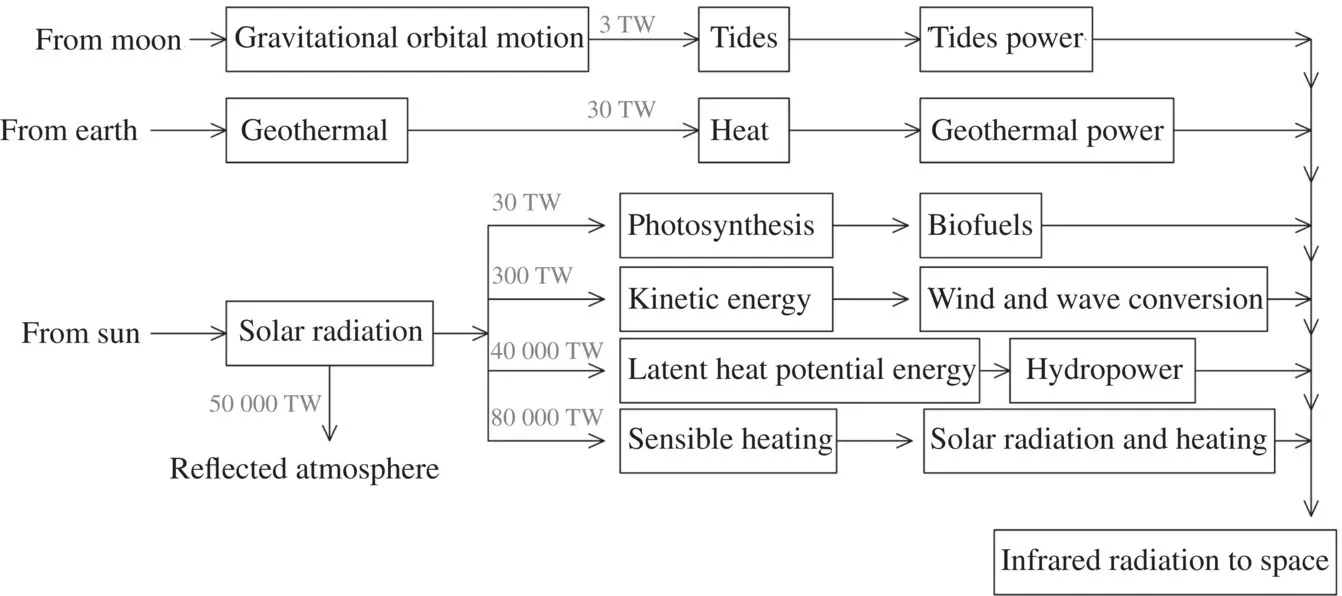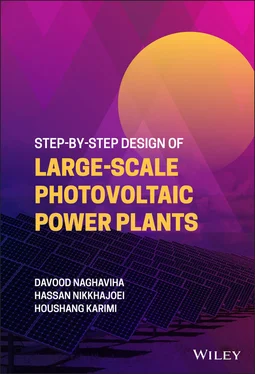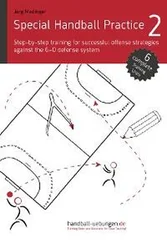Houshang Karimi - Step-by-Step Design of Large-Scale Photovoltaic Power Plants
Здесь есть возможность читать онлайн «Houshang Karimi - Step-by-Step Design of Large-Scale Photovoltaic Power Plants» — ознакомительный отрывок электронной книги совершенно бесплатно, а после прочтения отрывка купить полную версию. В некоторых случаях можно слушать аудио, скачать через торрент в формате fb2 и присутствует краткое содержание. Жанр: unrecognised, на английском языке. Описание произведения, (предисловие) а так же отзывы посетителей доступны на портале библиотеки ЛибКат.
- Название:Step-by-Step Design of Large-Scale Photovoltaic Power Plants
- Автор:
- Жанр:
- Год:неизвестен
- ISBN:нет данных
- Рейтинг книги:3 / 5. Голосов: 1
-
Избранное:Добавить в избранное
- Отзывы:
-
Ваша оценка:
- 60
- 1
- 2
- 3
- 4
- 5
Step-by-Step Design of Large-Scale Photovoltaic Power Plants: краткое содержание, описание и аннотация
Предлагаем к чтению аннотацию, описание, краткое содержание или предисловие (зависит от того, что написал сам автор книги «Step-by-Step Design of Large-Scale Photovoltaic Power Plants»). Если вы не нашли необходимую информацию о книге — напишите в комментариях, мы постараемся отыскать её.
Step-by-Step Design of Large-Scale Photovoltaic Power Plants,
Step-by-Step Design of Large-Scale Photovoltaic Power Plants
Step-by-Step Design of Large-Scale Photovoltaic Power Plants
Step-by-Step Design of Large-Scale Photovoltaic Power Plants — читать онлайн ознакомительный отрывок
Ниже представлен текст книги, разбитый по страницам. Система сохранения места последней прочитанной страницы, позволяет с удобством читать онлайн бесплатно книгу «Step-by-Step Design of Large-Scale Photovoltaic Power Plants», без необходимости каждый раз заново искать на чём Вы остановились. Поставьте закладку, и сможете в любой момент перейти на страницу, на которой закончили чтение.
Интервал:
Закладка:
1.2 Diverse Solar Energy Applications
Solar energy is used for two groups of applications: non‐power plant and power plant. Figure 1.2shows various applications of solar energy [2]. Based on Figure 1.2, solar power plants are divided into three categories: solar thermal; PV thermal hybrid; and PV.

Figure 1.1 Energy conversion cycle.
Source : Modified from Twidell and Weir [1].
1.2.1 Solar Thermal Power Plant
In a solar thermal power plant, the solar energy is converted into thermal energy which is then converted into electrical energy. Figure 1.3shows various types of solar thermal power plants as explained below [3].
1 Parabolic PlantThe parabolic plant has a linear parabolic collector consisting of few rows of parabolic reflectors. The reflectors absorb the reflected rays of solar radiation and warm up the heat transfer fluid.
2 Central Receiver PlantThe central receiver plant consists of a set of mirrors, where each separately concentrates solar energy and transmits it to a central receiver tower.
3 Parabolic Dish PlantIn a parabolic dish plant, the sun's rays reflected on a parabolic surface are concentrated at a focal point. The thermal energy is converted into mechanical energy by a Stirling engine. An electric generator converts the mechanical energy into the electrical energy.
4 Solar Chimney PlantIn a solar chimney plant, a combination of solar air collectors and air conduction towers are used to produce induced air currents. The currents provide mechanical forces in order to rotate a pressure step turbine coupled to a generator to produce electricity. Figure 1.2 Various solar power plant categories.Source: Dincer and Abu‐Rayash [2]. Figure 1.3 Various applications of solar thermal energy: (a) Parabolic plant, (b) Central receiver plant, (c) Parabolic dish plant, (d) Solar chimney plant, and (e) Fresnel collector plant.Source: Modified from González‐Roubaud et al. [3].
5 Fresnel Collector PlantThe Fresnel collector plant includes flat mirror collectors with low width and long length that collect the incoming sunlight on the concentrator and send it to a receiver tube. The receiver tube heats up the fluid inside the tube.
1.2.2 PV Thermal Hybrid Power Plant
The PV thermal hybrid power plant consists of a combination of PV panels and a solar thermal collector. The PV panels convert the solar radiation into electrical energy. The solar thermal collector absorbs remaining energy of the solar rays and also removes wasted heat from the panels.
1.2.3 PV Power Plant
In a PV power plant, the sun's radiant energy is directly converted into electrical energy. There are two categories of PV power plants: conventional and concentrated. Unlike the conventional plants, the concentrated PV plants employ curved lenses or mirrors to focus sunlight on high‐efficiency PV cells. A concentrated plant has a solar tracker and a cooling system, in some cases, to further increase the plant efficiency.
Depending on the application, PV power plants are divided into five categories as briefly explained below.
1 Grid‐connected PV Power PlantPV power plants are usually connected to the local power network. The schematic diagram of a grid‐connected PV plant is shown in Figure 1.4. For the grid‐connected PV plant, the generated electricity is either consumed immediately by local loads or is sold to electricity supply companies. The local loads may include commercial and/or industrial consumers.For the grid‐connected PV plant, the grid acts as an energy storage system and, therefore, there is no need to have battery storage. In the evenings, when the PV plant is unable to produce power, the required electricity can be purchased back from the power network [4].
2 Stand‐alone PV Power PlantThe stand‐alone PV plants are used in the remote areas that have no access to the power grid. A stand‐alone PV plant operates independent of the grid, with part of the produced energy stored in energy storage systems such as batteries. A schematic diagram of a stand‐alone PV plant is shown in Figure 1.5. A stand‐alone PV plant includes PV modules, an inverter, batteries, and a charge controller. The inverter converts the direct current generated by the PV modules to the alternating current for AC applications. The PV plant can supply both the DC and AC loads [4].
3 Direct‐coupled PV Power PlantIn a direct‐coupled PV plant, the PV array is connected directly to the load. The schematic diagram of a direct‐coupled PV plant is shown in Figure 1.6. The load can operate only when there is solar radiation and, therefore, the plant has limited applications. An application of this type of plant is water pumping, where the load operates as long as sunshine is available, and instead of storing the electrical energy, water is usually stored [5]. Figure 1.4 Schematic diagram of a grid‐connected PV plant.Source: Modified from Vázquez and Vázquez [4]. Figure 1.5 Schematic diagram of a stand‐alone PV plant.Source: Modified from Vázquez and Vázquez [4]. Figure 1.6 Schematic diagram of a direct‐coupled PV plant.Source: Modified from Kalogirou [5].
4 Hybrid‐connected PV Power PlantIn the hybrid‐connected PV plant, more than one type of generator is employed. In this type of power plant, one of the generators is a PV plant. The other generators can be wind turbine, diesel engine generator, or the utility grid. The diesel engine generator can also be a renewable source of electricity when the engine is fed with biofuels. The schematic diagram of a hybrid‐connected PV plant is shown in Figure 1.7. The plant can provide electricity for both DC and AC loads [5].
5 Grid Energy Storage Figure 1.8shows the schematic diagram of a grid energy storage PV power plant. The grid energy storage can be considered as a special model of hybrid‐connected plant. This type of power plant is used for countries where the guaranteed purchase tariff for electricity varies in peak, low, and medium load conditions. In the time periods when the guaranteed electricity purchase tariff is lower, the energy produced by the power plant is stored in batteries. When the tariff rate is higher at peak load conditions, the stored energy is injected into the grid to increase the annual revenue of the power plant. Figure 1.7 Schematic diagram of a hybrid‐connected PV plant.Source: Modified from Kalogirou [5]. Figure 1.8 Schematic diagram of a grid energy storage PV plant.
PV power plants can be installed almost anywhere. Based on the location of installation, the PV plants are divided into three main categories: residential, industrial and commercial, and utility‐scale. Figure 1.9shows the types of PV plants based on their installation location. A residential PV system provides power to a home and/or to the grid. A commercial and industrial PV plant supply power to a corporate organization or an industrial plant. A utility‐scale PV plant provides power to the grid.
Homeowners can benefit from installing a PV system in their property almost everywhere. Depending on the government policies, there are two configurations for operating a residential PV system. In the first configuration, the residential PV system supplies the home energy, and the surplus energy is injected to the grid to offset the electricity bill through net metering. In the second configuration, the produced energy by the residential PV system is totally injected to the grid by a separate meter than the home electricity meter. The price of energy sold to the grid is paid to the home owner. Note that a utility‐scale solar facility generates solar power and feeds it into the grid, i.e. supplying a utility with energy, whereas the commercial and industrial projects supply power to corporate organizations and industrial plants.
Читать дальшеИнтервал:
Закладка:
Похожие книги на «Step-by-Step Design of Large-Scale Photovoltaic Power Plants»
Представляем Вашему вниманию похожие книги на «Step-by-Step Design of Large-Scale Photovoltaic Power Plants» списком для выбора. Мы отобрали схожую по названию и смыслу литературу в надежде предоставить читателям больше вариантов отыскать новые, интересные, ещё непрочитанные произведения.
Обсуждение, отзывы о книге «Step-by-Step Design of Large-Scale Photovoltaic Power Plants» и просто собственные мнения читателей. Оставьте ваши комментарии, напишите, что Вы думаете о произведении, его смысле или главных героях. Укажите что конкретно понравилось, а что нет, и почему Вы так считаете.












